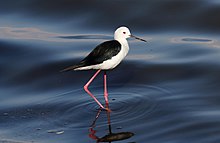Stilt
| Stilt | |
|---|---|

| |
| Adult black-winged stilt in Tanzania | |
| Scientific classification | |
| Domain: | Eukaryota |
| Kingdom: | Animalia |
| Phylum: | Chordata |
| Class: | Aves |
| Order: | Charadriiformes |
| Family: | Recurvirostridae |
| Genus: | Himantopus Brisson, 1760 |
| Type species | |
| Charadrius himantopus Linnaeus, 1758
| |
| Genera | |
| |
Stilt is a common name for several species of birds in the family Recurvirostridae, which also includes those known as avocets. They are found in brackish or saline wetlands in warm or hot climates.
They have extremely long legs, hence the group name, and long thin bills. Stilts typically feed on aquatic insects and other small creatures and nest on the ground surface in loose colonies.
Most sources recognize 6 species in 2 genera, although the white-backed and Hawaiian stilts are occasionally considered subspecies of the black-necked stilt.
The genus Charadrius was introduced by the French zoologist Mathurin Jacques Brisson in 1760 with the black-winged stilt (Himantopus himantopus) as the type species.[1][2] The generic name Himantopus comes from the Ancient Greek meaning "strap-leg".[3]
Species
[edit]The genus Himantopus contains five species:[4]
- Black-winged stilt, Himantopus himantopus
- White-backed stilt, Himantopus melanurus
- Pied stilt, Himantopus leucocephalus
- Black-necked stilt, Himantopus mexicanus
- Hawaiian stilt or aeʻo, Himantopus mexicanus knudseni
- Black stilt, Himantopus novaezelandiae
The genus Cladorhynchus is monotypic and contains a single species:[4]
- Banded stilt, Cladorhynchus leucocephalus
A fossil stilt has been described by Bickart, 1990, as Himantopus olsoni, based on remains recovered in the Late Miocene Big Sandy Formation of Mohave County, Arizona, United States.[5]
References
[edit]- ^ Brisson, Mathurin Jacques (1760). Ornithologie, ou, Méthode Contenant la Division des Oiseaux en Ordres, Sections, Genres, Especes & leurs Variétés (in French and Latin). Paris: Jean-Baptiste Bauche. Vol. 1, p. 46, Vol. 5, p. 33.
- ^ Peters, James Lee, ed. (1934). Check-list of Birds of the World. Vol. 2. Cambridge, Massachusetts: Harvard University Press. p. 289.
- ^ Jobling, James (2010). Helm Dictionary of Scientific Bird Names. London: Helm. p. 191. ISBN 978-1-4081-2501-4.
- ^ a b Gill, Frank; Donsker, David, eds. (2019). "Buttonquail, plovers, seedsnipe, sandpipers". World Bird List Version 9.1. International Ornithologists' Union. Retrieved 3 April 2019.
- ^ Bickart, K. J. (1990). "Part I: The Birds of the Late Miocene-Early Pliocene Big Sandy Formation, Mohave County, Arizona". Ornithological Monographs (44): 1–72. doi:10.2307/40166673. JSTOR 40166673.



